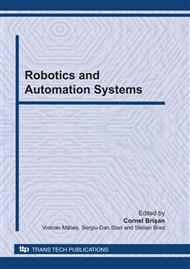p.241
p.247
p.253
p.259
p.265
p.271
p.277
p.285
p.291
Feature Based Mapping Procedure with Application on Simultaneous Localization and Mapping (SLAM)
Abstract:
We are presenting a feature based mapping procedure applied on data reduction to the relevant information used for autonomous navigation. The proceeding is based on the evaluation of the environment using a SICK LD laser scanner. We assume that laser scanners have the advantage of producing reliable data with well understood characteristics for map generation. By implementing evolutive algorithms we process data into lines representing edges of the surrounding objects and create a simplified representation of the environment (feature based). Because of the dynamic generation and evolution of the map, during the movement of the autonomous vehicle we are considering of merging and fitting the data by applying a shape correlation. The goal of our project defines the capability of a fully autonomous vehicle to safely drive through the environment until reaching the standard parking lots and complete autonomous parking procedures.
Info:
Periodical:
Pages:
265-270
Citation:
Online since:
September 2010
Authors:
Price:
Сopyright:
© 2010 Trans Tech Publications Ltd. All Rights Reserved
Share:
Citation:


